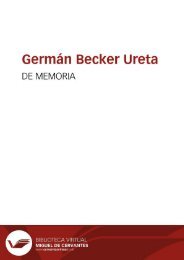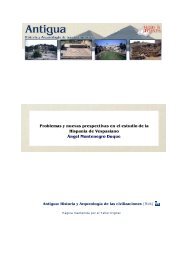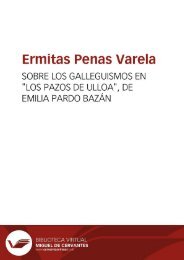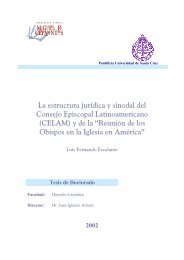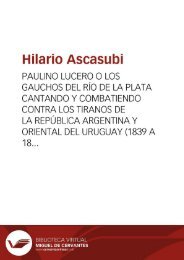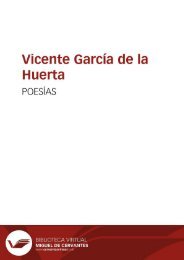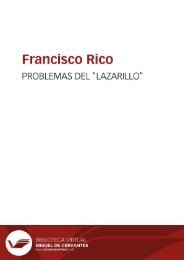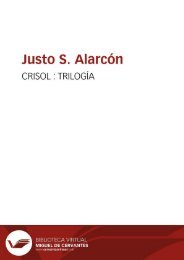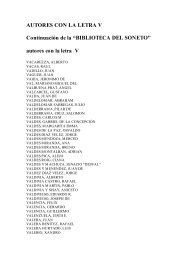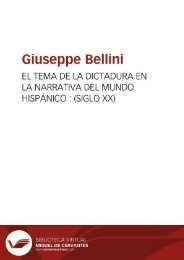Create successful ePaper yourself
Turn your PDF publications into a flip-book with our unique Google optimized e-Paper software.
Anales galdosianos [Publicaciones periódicas]. Año XII, 1977<br />
characterization 81 . In his pursuit of an obsolete religious ideal, Orozco brings to mind Don Quijote,<br />
who followed the antiquated ideals of chivalry in the seventeenth century 82 . The madness of Orozco's<br />
quijotismo surfaces in his rapidly debilitating mental state, which Augusta constantly hints at, and<br />
49-52. The basis of my comparison is the interplay between reality and illusion within a love triangle,<br />
whereby both Orozco and Anselmo emerge as quixotic figures, whereas that of Girard's comparison is<br />
the mediation of desire, whereby Pavel Pavlovitch and Anselmo are examples of internally mediated<br />
desire, distinguishing them from Quijote, who is an example of externally mediated desire. I should<br />
further note that, considered from Girard's perspective, Orozco's desire is externally mediated: upon<br />
learning of Augusta's infidelity, he struggles to suppress his natural inclination to feel jealous, because<br />
of his own ideal of self-perfection, which contemns ordinary human feelings.<br />
81 Several critics have remarked on some of these parallels. J. Chalmers Herman, Don Quijote and<br />
the Novels of Pérez <strong>Galdós</strong> (Ada, Oklahoma: East Central Oklahoma State College, 1955), briefly<br />
discusses Viera's quijotismo (pp. 30-31), and observes that: «The letters that Manuel Infante and<br />
Equis write to each other in La incógnita recall at times the verbal exchanges between Don Quijote<br />
and his Squire. This is especially true in the very last missive in which Equis calls upon his friend<br />
to believe the incredible just as Sancho and Don Quijote invoke the credulity of each other...» (p.<br />
44). Monroe Z. Hafter, «Ironic Reprise in <strong>Galdós</strong>' Novels», PMLA , 76 (1961), 233-239, describes<br />
Viera and Orozco as similar quixotic figures (p. 238). And finally, Gullón, op. cit. , lists Viera as a<br />
quixotic character (p. 58). I might add that the characterization of Infante and Equis in the account of<br />
the magical self-structuring of Realidad brings to mind Cide Hamete, the fictitious chronicler, who,<br />
although he has the magical power to reveal the most hidden thoughts ( Quijote , Part II, Chapter<br />
40), also has the limitation of occasionally being unreliable (Part I, Chapter 9; and Part II, Chapter<br />
3): Infante is a fictitious author and frequently unreliable narrator; Infante, believing Equis to be the<br />
author of the manuscript, attributes to him « un poder de adivinación » to « ver la cara interior de<br />
los hechos humanos » (p. 786). This account, then, functions as a preamble to the parallels between<br />
Realidad and the Quijote .<br />
82 It is interesting to note that Don Quijote's virtuousness is not unambiguous; see the polemical<br />
articles of A. A. Parker, «Don Quixote and the Relativity of Truth», The Dublin Review , 44 (1947),<br />
28-37; Helmut A. Hatzfeld, « ¿Don Quijote asceta? », NRFH , 2 (1948), 57-70; and Amado Alonso,<br />
« Don Quijote no asceta, pero ejemplar caballero y cristiano », NRFH , 2 (1948), 333-359, rpt. in<br />
Materia y forma en poesía , pp. 159-200.<br />
54



